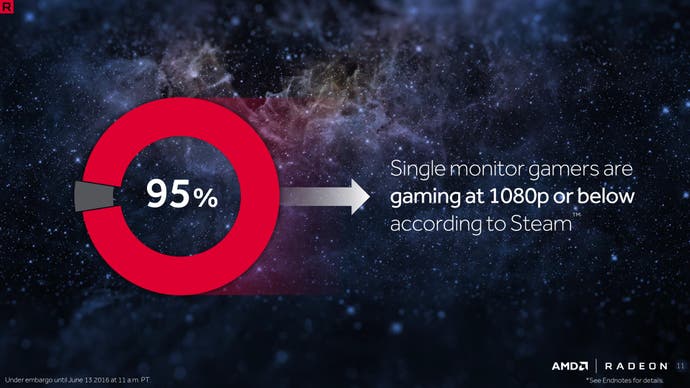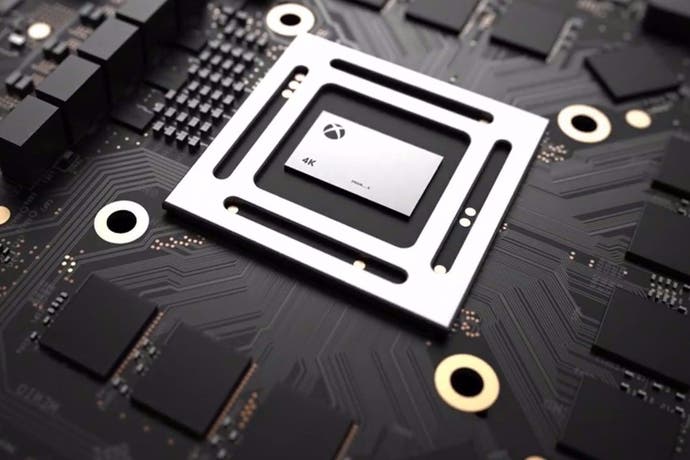Are 4K visuals really the best use for Project Scorpio and PlayStation Neo?
Higher frame-rates and richer gameplay experiences will have more impact than pixel-count.
With the reveal of Microsoft's Project Scorpio and Sony's PlayStation Neo, the platform holders find themselves at a crossroads. Whether it's a 2.3x or 4x increase in processing power compared to their predecessors, the question is, just how should these resources be used to improve the games we play? As things stand, we've been told to expect higher resolutions, increased fidelity and more stable frame-rates, but the ambition here sounds limited when the hardware is capable of so much more.
The bottom line is this: both Sony and Microsoft are effectively selling us the status quo in terms of gameplay, the idea being that they can create a two-tier market - existing console hardware caters for those with 1080p displays while the new machines are best experienced paired with a 4K UHD screen. But fundamentally, it's the same software, and in order to ensure that owners of existing systems are "not left behind", the chances are that they'll play much the same too. Indeed, Sony's guidelines for developers actively prohibit game-makers from providing exclusive features for the Neo hardware.
Cards on the table here - I'm not entirely sure that this is the best way forward, but I am one of the few to have had a preview of this kind of next-gen experience - and I was blown away. At the recent Nvidia GeForce GTX 1080 launch, I played Rise of the Tomb Raider at native 4K with HDR enabled and with quality settings that, while not quite maxed, easily out-strip the Xbox One version. Aside from what looked like a wobbly 35-40fps (something easily fixed) the experience was simply magnificent. Improved effects, higher detail texture work, brilliantly vivid colour - this was the best Rise of the Tomb Raider experience it's possible to have, and compared to the existing console version, there was undoubtedly a 'next-gen' feel about it.
But the bottom line is that the full impact of this experience depends on ownership of a top-tier display that currently costs a lot of money. Stripped of HDR and its immense detail level, this demo would not translate particularly well when downsampled to a standard 1080p screen. And that's the display hardware that the vast majority of these new machines are likely to end up connected to. In this scenario, all you'd get is improved anti-aliasing, while other features - like the higher detail textures - tend to blur away in the downscale. This is exactly the point made by Phil Spencer, when he told Giant Bomb that Scorpio games would "look different" and "run a little better" when paired with 1080p displays, and presumably why he told Wesley Yin-Poole to stick with Xbox One if you aren't 4K-enabled.
But there's something else worth mentioning too - these new consoles are potent and a significant improvement over PS4 and Xbox One, but let's be clear - they're not all-powerful. GTX 1080 is the most capable consumer GPU on the planet today. It offers more raw gaming power than Scorpio can hope to, and positively annihilates PlayStation Neo. If the Tomb Raider demo I experienced were ported to console, the chances are we'd see reduced resolution and cut-back effects work, further narrowing the gap between old gen and new - even if it were played on an HDR-equipped 4K screen.
The real question is, could this new console technology be used differently, to achieve tangibly superior results that wouldn't require investing in a new TV? Could Neo and Scorpio actually be used to deliver better gameplay? Resolution aside, there are further options open to developers armed with this substantial boost in GPU power - many titles could be run at 60fps over the standard 30fps, the biggest game-changer in terms of playability. Alternatively, in-game worlds could become deeper, with a much higher degree of simulation - more NPCs, better physics, real-time global illumination - you name it. More time can be invested by developers in GPGPU, the process of utilising graphics hardware for tasks more traditionally suited to the CPU.
Scorpio and Neo could literally become game-changers, but there are always trade-offs when it comes to hardware utilisation and it would almost certainly mean an end to any aspirations of 4K support, or anything close to it. It would also mean that a generational divide would start to open up between old-gen and new. Both Sony and Microsoft are mandating that this divide must not happen, but realistically, this rule is going to bent out of shape pretty quickly and I expect it to be a thing of the past within the next two to three years. The key point is this: assuming a two/three year development period, games going into production now will launch in 2018/2019. Are developers really going to fully support vintage 2013 consoles by then?
I do have to wonder how long the 'no-one gets left behind' strategy will remain in effect, and I suspect it's all going to be down to adoption figures for the new consoles. And we may well find ourselves in a chicken and egg situation here: if the benefit is only found mostly for those with 4K displays, take-up will be artificially limited. Looking closely at Sony's developer guidelines for Neo development, it seems that the platform holder is OK with game-makers embellishing 1080p presentations, and while 4K and higher resolutions is encouraged, there is no hard and fast mandate here. This may well be how Neo overcomes the issue of its lower spec - by handing in enhancements that can actually appreciated by those with 1080p screens, assuming Microsoft goes all-in on 4K. In fact, the only resolution guideline I can find in the Neo docs is an absolute minimum of 1080p - which will be absolutely fine for the majority of gamers.
In the meantime, Microsoft has its own larger scale strategy that's arguably more important than any upcoming hardware launch - effectively taking Xbox cross-platform, and dual-releasing key software on both console and Windows 10. It could work out rather well for them. On June 29th, AMD launches the Radeon RX 480 graphics card for $199. It's noteworthy in that at an architectural level it is extremely similar to the PlayStation Neo graphics tech, the main difference coming from clock-speed: the Sony console runs its GPU at 911MHz, the RX 480 will be faster - leaks are indicating a 1266MHz boost clock. If that's true, it would bring its overall computational power closer to Scorpio's projected capabilities.
And being a PC part, we would be able to tailor the gameplay experience however we want it. The RX 480 - and presumably its upcoming GTX 1060 competitor - are set to offer performance that improves on the R9 390 and GTX 970. And that's significant. These are our 'go to' cards when we want to run games at console-equivalent settings - or better - at 1080p60. It's an outlier but in the case of Forza Motorsport Apex, the game even runs locked for the most part at 1440p with 8x MSAA on this class of hardware, which obviously bodes well for a superb Forza 7 experience on Scorpio.

But the graphic above from AMD is telling. According to the Steam hardware survey, 95 per cent of PC gamers are using 1080p or lower resolution screens. 1440p and 4K displays barely register, neither failing to hit even one per cent of the audience. 4K may well gain more traction in the living room, but the inescapable conclusion from the PC market is that the majority of gamers simply don't care about higher resolution screens. And with that in mind, the RX 480 is AMD's audacious play at targeting the mainstream PC gamer - and there is some irony that the same core technology is fuelling Sony's 4K aspirations.
Work still needs to be done on ensuring a great experience on a range of PC kit 'out of the box' - which is something I believe Microsoft is set to put a lot of work into - but it seems that the move to a mid-gen console refresh cycle is going to be a difficult sell. And already there are signs that PC hardware manufacturers may adapt sooner, with more powerful parts. Check out this motherboard scoped out at the recent Computex trade-show: it'll house a standard Intel Skylake chip, and right next to it is an embedded GTX 1070 from Nvidia. It'll be pricey for sure, but plug in a £150 Core i5 6500 and 8GB of DDR4 and you have a small form-factor Windows PC that already offers more power than either next-gen console.
Several sources have indicated to me that PlayStation Neo launches this year, despite its E3 no-show. If that is the case, it'll be interesting to see how developers utilise its resources, and whether 4K really is the focus. And we can be equally as sure that Microsoft will be watching just as intently as it gears up for its own next-gen roll-out.



